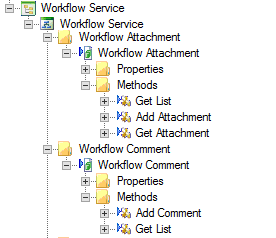Workflow Service
The Workflow Service Service Type exposes runtime operations for adding comments and attachments to a workflow. A service instance of this service type is registered automatically when you install K2. You do not need to register another instance.
Service Authentication
The following Authentication Modes may be used with the Service Type:
- Impersonate
- ServiceAccount
- Single Single-on
- Static
Service Keys (Service Instance Configuration Settings)

| Key | Can be modified | Data Type | Sample Value | Notes |
|---|---|---|---|---|
| Workflow Server | Yes | Text |
Integrated=True;IsPrimaryLogin=True; Authenticate=True;EncryptedPassword=False; Host=localhost;Port=5252 This property contains sensitive information. You can enter and see your values when you first configure this value. The value will be masked when the service instance is updated. |
Connection string to the K2 server |
| Workflow LogDB Connection String | Yes | Text |
Data Source=[SqlServerName];Initial Catalog=K2;integrated security=sspi; Pooling=True This property contains sensitive information. You can enter and see your values when you first configure this value. The value will be masked when the service instance is updated. |
SQL connection string to the K2 database |
| Workflow DB Connection String | Yes | Text |
Data Source=[SqlServerName];Initial Catalog=K2;integrated security=sspi; Pooling=True This property contains sensitive information. You can enter and see your values when you first configure this value. The value will be masked when the service instance is updated. |
SQL connection string to the K2 database |
Service Objects
During installation of K2, the Workflow Service Service Instance creates Service Objects in the Workflow Service category, which are used by K2 to manage comments and attachments to workflow instances. The screen shot below shows the available methods of these Service Objects.

SmartObjects
K2 automatically generates SmartObjects for these Service Objects. SmartObjects can be automatically created by selecting the Generate SmartObjects for this Service Instance check box when creating a new Service Instance. Designers can use the SmartObject design tools to build advanced SmartObjects that leverage the Service Objects in this service. It is recommended to use the SmartObject design tools to create SmartObjects rather than generating SmartObjects, since this allows better control over the naming, behavior and design of the SmartObject and its methods and properties.